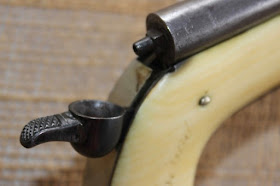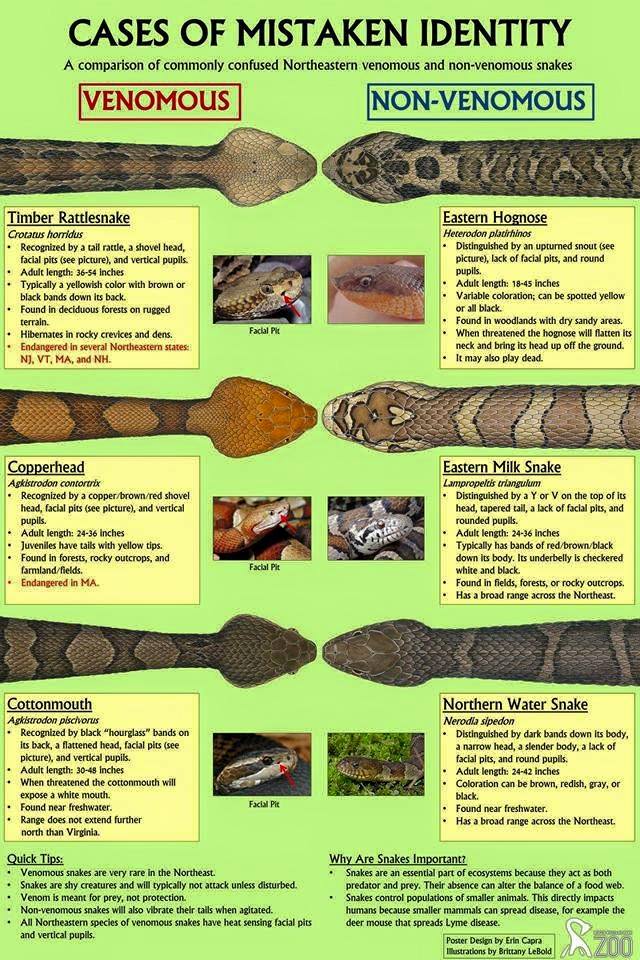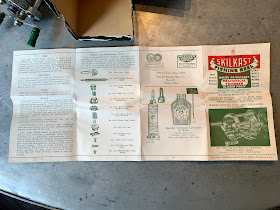Click on photo for a larger view.
Pages
▼
Antique Tresch Knife Pistol and Alarm Gun
 TRESCH KNIFE PISTOL AND ALARM GUN. This unique example of a Tresch knife pistol is a single shot percussion, with a 4 inch double edge spring blade and bone grips. When pressed backward, the tip releases from the cup under the muzzle. This releases it to be used as a rammer. The rammer is attached on the underside; you press backward on it and the tip releases from the cup under the muzzle. This allows it to be used as a rammer. The .33 caliber barrel is 5 inches long. The trigger is designed to serve double duty as an awl so the piece can be used as an alarm gun. The left grip is inscribed “Le Blendel” and the right grip is inscribed “G.Gerard.” This one is listed on Gunbroker.com for sale.
TRESCH KNIFE PISTOL AND ALARM GUN. This unique example of a Tresch knife pistol is a single shot percussion, with a 4 inch double edge spring blade and bone grips. When pressed backward, the tip releases from the cup under the muzzle. This releases it to be used as a rammer. The rammer is attached on the underside; you press backward on it and the tip releases from the cup under the muzzle. This allows it to be used as a rammer. The .33 caliber barrel is 5 inches long. The trigger is designed to serve double duty as an awl so the piece can be used as an alarm gun. The left grip is inscribed “Le Blendel” and the right grip is inscribed “G.Gerard.” This one is listed on Gunbroker.com for sale.Know your snakes! Venomous Snake ID Chart With Pictures
I came across the following chart on the MD DNR Wildlife & Heritage Service Facebook page today and thought you might find it helpful. While I'm not frightened of snakes and actually like them, it's good to know which ones to steer clear of, right?
Stay safe and enjoy the wonders of the natural world responsibly!
A Guide to Identifying Poisonous or Dangerous Snakes
Introduction:
Snakes are fascinating creatures that play an important role in our ecosystems. However, it's essential to be able to identify poisonous or dangerous snake species to ensure safety, especially when venturing into their habitats. This guide aims to provide you with the knowledge and tools necessary to distinguish these venomous snakes from harmless ones.
1. Research and Familiarize Yourself:
Before heading out into snake-prone areas, it's crucial to research the types of snakes that inhabit your region. Understand their habitats, behaviors, and distinctive features. Local herpetological societies, field guides, and online resources can provide valuable information.
2. Head Shape and Eye Characteristics:
Venomous snakes often have triangular-shaped heads, while non-venomous snakes typically have more rounded heads. Additionally, pay attention to eye characteristics. Most venomous snakes have elliptical, vertically-slitted pupils, whereas non-venomous snakes generally have round pupils.
3. Venomous Snake Species:
Now let's focus on some common venomous snake species and how to identify them:
a. Pit Vipers:
- Rattlesnakes, copperheads, and cottonmouths (water moccasins) belong to this group.
- Look for a heat-sensing pit located between the eye and nostril on each side of the head.
- Rattlesnakes have rattles at the tip of their tails, which produce a distinct sound when threatened.
b. Coral Snakes:
- These small snakes have red, yellow, and black banding patterns.
- Remember the rhyme: "Red touches yellow, kill a fellow; red touches black, venom lack."
4. Harmless Snake Species:
To avoid unnecessary panic or harm to harmless snake species, it's essential to learn how to differentiate them from venomous ones. Here are a few examples:
a. Rat Snakes:
- Rat snakes are non-venomous constrictors that can grow quite long.
- They have slender bodies and large, round eyes.
b. Garter Snakes:
- These harmless snakes are commonly found near water sources.
- They typically have longitudinal stripes running along their bodies.
5. Seek Professional Guidance:
If you encounter a snake that you can't identify confidently, it's best to seek assistance from local experts or wildlife authorities. They can provide accurate information and handle any potentially dangerous situations.
Conclusion:
Being able to differentiate between poisonous or dangerous snakes and harmless snake species is crucial for personal safety and snake conservation efforts. By familiarizing yourself with their unique characteristics, behaviors, and habitats, you can coexist with these fascinating creatures more confidently and responsibly.
Remember, respecting the boundaries of these animals and their habitats is essential. Avoid provoking or harming any snake species, as they play a vital role in maintaining ecological balance.
Pflueger Skilcast No. 1953 Fishing Reel Level Wind Baitcaster
No.1953A Insert TEXT
LINE CAPACITY- SEE INSERT PPLUEGER FISHING REEL QUADRUPLE Many LEVEL WINDS Original MICRO ADJUSTABLE MULTI Features Patented MECHANICAL THUMBER/ BLISTER PROOF
Give Your Reel Proper Care It is a fine piece of mechanism, and a little attention in the way of keeping it clean and properly lubricated will be well repaid by the long and satisfactory service you will receive from it. If the reel s used around salt water, or in fresh waters containing corrosive elements, it is well to wipe the reel all over with an oiled rag before using, and after use remove the line and clean all parts, inside and out. The attractive finish of this reel can be preserved indefinitely by using care from the beginning along these lines.
Notice-this reel SHOULD BE OILED BEFORE USING. While every reel is well oiled at the time it is made the best of oils will evaporate under certain conditions, so that every new reel should be oiled all around before it is used.
Directions for Oiling
Pflueger Speede Reel Oil is especially compounded for best results on fishing reels.
Do not remove oil cup (Point S) but turn oiling dise so that hole appears, and place a drop or two of oil in same. Turn disc to cover oil hole again.
Repeat operation with oiling disc in thumbing device (Point W), using 3 or 4 drops of light oil.
Put 2 or 3 drops of oil through crank nut oil hole.
(Point K) for the cog post on which the gear revolves. It is particularly important in a new reel to see that ths point is well oiled, otherwise the gear will "Freeze up. " Turn reel over and place a few drops-of oil on both cads of double thread shaft (Point O). This part should be oiled every few hours while the reel is in active use.
Oil the reel as above at least once a day. An occasional drop of oil on each handle rivet is advisable.
Cleaning and Greasing
It should not be necessary to take this reel apart for greasing oftener than once or twice a season unless it has become full of dirt. In that event proceed as follows: (Point K) and crank (Point E). Remove cap of reel by taking out the three cap screws (Point Q indicates one of them). Loosen retainer screw (Point T) only enough to allow cover to be turned and half nut removed. Remove gear and shaft pinion, also double thread shaft, which will release the line guide block (L). Remove 2 housing screws in back plate and take out double thread shaft housing (Point M). Lift off front plate (Point D) and remove spool (Point D). After cleaning all parts place 2 or 3 drops of oil in pivot bearing in back plate, and assemble reel, reversing the operations as above, After the gear and pinions are in place, put a small amount of grease on the gear, also on the click ratchet (do not use too much at one time only enough to cover the gear teeth). Pflueger Runtree Gear Grease, being specially prepared for that purpose, is the best gear lubricant to use, Oil the cog post and place 2 or 3 drops of oil in front pivot bearing before replacing cap of reel Oil the double thread shaft as previously instructed.Do not use gear grease on this part.
Level Wind Mechanism This part is vitally important in a reel of this kind, and in the SKILKAST Reel special attention has been given to producing a combination of double thread shaft and half nut or pawl that will give long and satisfactory service. Both of these parts are made of selected steel, with the utmost accuracy, specially treated bto resist wear and corrosion. For emergency use, as sometimes the pawl will become damaged by a grain of sand or some other obstruction getting into the reel, an EXTRA HALF NUT or pawl is provided, carried in a receptacle built into the reel (see Point U).
Note-In replacing the half nut or pawl after removal for cleaning it is of the utmost importance THAT IT BE PROPERLY SEATED IN THE DOUBLE THREAD SHIAFT BEFORE THE COVER SCREW IS TIGHTENED UP. You will notice a hole in the back of the half mut (there is no spring used here) but by inserting a match stick or similar object it is a simple matter to lift aut the halE nut, and to replace it in the same manner. Test the reel carefully until you are sure the half nut is properly seated.
Tenslon Oil Cup
Do not use oil cup as a drag by tightening it up so as to retard the spinning of the spool. It is intended only to adjust end play and to keep the spool properly centered in the reel. In adjusting oil cup tighten it until the spool will not turn freely-then back it off a quarter turn. By reason of the patented tension device the oil cup is held firmly just where you set it, and will not work loose or become lost.
MECHANICAL THUMBER
If desired, may be entirely removed and reel will operate as standard reel.
This device makes it unnecessary to thumb the reel after cast is started-works only when line is running out. Adjustable with micro-precision (by turning part "H" right or left) to the size of line and weight of lure used. A little experimenting will soon indicate to you the proper degree of tension required.
CAUTION-Use 2 or 3 drops of light oll at frequent intervals while casting. It is not necessary to take apart this assembly for cleaning unless reel is dropped in the water and gets full of sand, etc. In taking it apart be careful not to lose the STEEL BALLS.
LINE CAPACITY- SEE INSERT PPLUEGER FISHING REEL QUADRUPLE Many LEVEL WINDS Original MICRO ADJUSTABLE MULTI Features Patented MECHANICAL THUMBER/ BLISTER PROOF
Give Your Reel Proper Care It is a fine piece of mechanism, and a little attention in the way of keeping it clean and properly lubricated will be well repaid by the long and satisfactory service you will receive from it. If the reel s used around salt water, or in fresh waters containing corrosive elements, it is well to wipe the reel all over with an oiled rag before using, and after use remove the line and clean all parts, inside and out. The attractive finish of this reel can be preserved indefinitely by using care from the beginning along these lines.
Notice-this reel SHOULD BE OILED BEFORE USING. While every reel is well oiled at the time it is made the best of oils will evaporate under certain conditions, so that every new reel should be oiled all around before it is used.
Directions for Oiling
Pflueger Speede Reel Oil is especially compounded for best results on fishing reels.
Do not remove oil cup (Point S) but turn oiling dise so that hole appears, and place a drop or two of oil in same. Turn disc to cover oil hole again.
Repeat operation with oiling disc in thumbing device (Point W), using 3 or 4 drops of light oil.
Put 2 or 3 drops of oil through crank nut oil hole.
(Point K) for the cog post on which the gear revolves. It is particularly important in a new reel to see that ths point is well oiled, otherwise the gear will "Freeze up. " Turn reel over and place a few drops-of oil on both cads of double thread shaft (Point O). This part should be oiled every few hours while the reel is in active use.
Oil the reel as above at least once a day. An occasional drop of oil on each handle rivet is advisable.
Cleaning and Greasing
It should not be necessary to take this reel apart for greasing oftener than once or twice a season unless it has become full of dirt. In that event proceed as follows: (Point K) and crank (Point E). Remove cap of reel by taking out the three cap screws (Point Q indicates one of them). Loosen retainer screw (Point T) only enough to allow cover to be turned and half nut removed. Remove gear and shaft pinion, also double thread shaft, which will release the line guide block (L). Remove 2 housing screws in back plate and take out double thread shaft housing (Point M). Lift off front plate (Point D) and remove spool (Point D). After cleaning all parts place 2 or 3 drops of oil in pivot bearing in back plate, and assemble reel, reversing the operations as above, After the gear and pinions are in place, put a small amount of grease on the gear, also on the click ratchet (do not use too much at one time only enough to cover the gear teeth). Pflueger Runtree Gear Grease, being specially prepared for that purpose, is the best gear lubricant to use, Oil the cog post and place 2 or 3 drops of oil in front pivot bearing before replacing cap of reel Oil the double thread shaft as previously instructed.Do not use gear grease on this part.
Level Wind Mechanism This part is vitally important in a reel of this kind, and in the SKILKAST Reel special attention has been given to producing a combination of double thread shaft and half nut or pawl that will give long and satisfactory service. Both of these parts are made of selected steel, with the utmost accuracy, specially treated bto resist wear and corrosion. For emergency use, as sometimes the pawl will become damaged by a grain of sand or some other obstruction getting into the reel, an EXTRA HALF NUT or pawl is provided, carried in a receptacle built into the reel (see Point U).
Note-In replacing the half nut or pawl after removal for cleaning it is of the utmost importance THAT IT BE PROPERLY SEATED IN THE DOUBLE THREAD SHIAFT BEFORE THE COVER SCREW IS TIGHTENED UP. You will notice a hole in the back of the half mut (there is no spring used here) but by inserting a match stick or similar object it is a simple matter to lift aut the halE nut, and to replace it in the same manner. Test the reel carefully until you are sure the half nut is properly seated.
Tenslon Oil Cup
Do not use oil cup as a drag by tightening it up so as to retard the spinning of the spool. It is intended only to adjust end play and to keep the spool properly centered in the reel. In adjusting oil cup tighten it until the spool will not turn freely-then back it off a quarter turn. By reason of the patented tension device the oil cup is held firmly just where you set it, and will not work loose or become lost.
MECHANICAL THUMBER
If desired, may be entirely removed and reel will operate as standard reel.
This device makes it unnecessary to thumb the reel after cast is started-works only when line is running out. Adjustable with micro-precision (by turning part "H" right or left) to the size of line and weight of lure used. A little experimenting will soon indicate to you the proper degree of tension required.
CAUTION-Use 2 or 3 drops of light oll at frequent intervals while casting. It is not necessary to take apart this assembly for cleaning unless reel is dropped in the water and gets full of sand, etc. In taking it apart be careful not to lose the STEEL BALLS.

















































